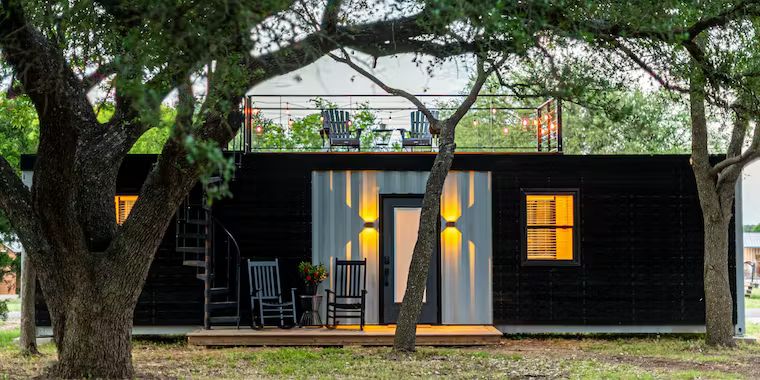SPRING SALE: Receive $100 Off Per Container
Winter is here, the days are getting shorter and darker which means it’s time to get your 20ft, 40ft, or 40ft HC container ready for the winter days ahead.
Tips For Maintaining Your Shipping Container During The Winter
Corten steel and wood shipping containers are designed to keep everything inside safe from the environment such as sun, snow, wind, and even rodents. While able to stay wind & watertight, they can be affected from weather extremes. We recently sat down with our Customer Care Lead Jessica Mascek to learn about how to prepare your container for winter and the changes of the season.
“While durable and able to withstand the harsh tenure at sea, containers can also benefit from a little TLC this time of year. If you live in an area that customarily gets substantial amounts of snow, make sure to inspect the container for holes along the sides and roof of the container. Keep joints lubricated and to remove extra surface dirt with a mixture of water and Windex.” Mascek added.
“Preserving container life is one of the primary focuses of Eveon. While no longer deemed seaworthy, shipping containers are still an effective sustainable building and storage solution once retired from sea. Regular checkups and care can keep them protecting your items for years to come!”
Other Recommendations & Care Tips From Eveon Containers...
Change In Humidity Condensation is often one of the first things people experience inside a container. If you live in a city with significant seasonal temperature changes or winter temperatures that drop below freezing, condensation can be an issue. If the sun is shining and the outside of the container warms up, the steel no longer matches the temperature inside the container, condensation can build up. If there is a temperature change between the air inside and outside the container, water droplets will appear. Instead of condensation building up on the outside of the container like a water glass, it will appear on the inside. Often referred to as “container rain” this occurs when water droplets appear on the container walls and ceiling, drip onto the floor. This rain can lead to issues in the future, such as mold, mildew, and rust.
Condensation while is more prevelant in wintertime, it can happen anytime of the year and in other climates as well—especially humid ones. So no matter where you live, if condensation is an issue, you could install vents. You can install it on the end walls, container doors, and sidewalls. Best is to install two vents diagonally, so air can match the outside temperature. 90% Of the time this will resolve your issue.
Container frozen to the ground: When containers are positioned directly on the ground, without blocks underneath the corner posts, it might end up sinking into the ground. Once it sinks into the ground and the ground freezes, your container is now frozen to the ground, and it is difficult to winch it out. So, if you plan to move your container during winter at all, ensure you have placed blocks beneath the corner posts so it's easier to move when you need to.
Roof damage: Another way to prepare for winter is to check your container for damage, such as rust or pinholes. If you live in an area that gets snow accumulation during the winter, it is important to inspect the container for structure damage. So, before winter hits, do a walk around of your container—especially the roof— and check for damages. See if there are any areas that hold water or places that are starting to cave in. Push out any dents holding water and silicone or caulk pinholes where the sun is creeping in.
Maintain moving parts: Keep an eye on the doors’ joints. By oiling and opening them now and then, you prevent the joint from rusting and fusing together. Just like us, the container doors can get a little stiff during the winter. “Use WD40 on doors and joints to keep them lubricated in the harsh winter months.” Shine noted.
Inspect and Seal Your Container:. Ensuring your shipping container is properly sealed is crucial to maintaining a stable environment, especially in winter. Examine the container's walls, doors, and roof for cracks, gaps, or any damage that could allow air, moisture, or pests to infiltrate. Sudden changes in humidity and airflow can lead to condensation buildup, rust, and potential structural damage. Use high-quality sealants or weatherproofing materials to patch any identified areas. Additionally, check the container's door seals for wear and replace them if necessary to maintain airtight integrity. A well-sealed container helps protect its contents and ensures it remains dry and insulated throughout the colder months.
Proper Care of Your Used Container Will Extend Life For Years To Come
Following these simple steps can help ensure the life of your Eveon container and help protect your equipment and cargo for years to come! If you have any specific questions about preparing your container for winter, do not hesitate to to call one of our agents at 888-489-7585 or click below to learn more about our available inventory.
Read more about our containers
We just can't get enough

How to buy a shipping container online at Eveon Inc.
You might be wondering how to buy a shipping container online. At Eveon Containers Inc., we make buying used shipping containers online as easy as picking your size, paying, and preparing for delivery! You can even pick your container up from the depot if you would like to expedite the process. Our pricing is fair and transparent. Whether you need a shipping container for the storage of goods, to ship items cross country, or to repurpose a container into a swimming pool, or affordable housing, look no further than our easy-to-use webshop.
Create a shipping container pool
Keen on creating a shipping container pool from our containers at Eveon Inc.? Look no further than our range of used shipping containers that can be reused according to your desired purpose. Shipping container pools are up-and-coming — containers can generally be reused for a range of different purposes, including pop-up medical clinics, low-cost housing, on-site construction offices, and more.

Shipping container homes — Sustainable inspiration from Eveon
Want to create the best shipping container homes? This is a superb sustainable option that also makes for a cheap housing solution. Shipping container homes are gaining popularity across the globe and with younger and older generations. That’s because containers are cheap, sustainable, modular, and therefore highly functional for use as a home.



